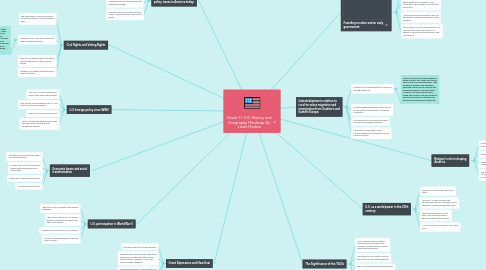
1. Great Depression and New Deal
1.1. The issues that led to Federal Reserve.
1.2. What was the principal cause of the Great Depression and the steps taken by the federal reserve, congress, Hoover, and Franklin Delano Roosevelt.
1.3. What were the effects of the New Deal on the economy
1.4. Creations of organizaed labours.
2. U.S. participation in World War II
2.1. Why the USA got invovled as well as their strategies.
2.2. The roles and sacrifices of American soldiers on both the European front and Pacific theater.
2.3. Foreign policy and affects on U.S. citizens.
2.4. The use of advanced weaponry and the atomic bombs.
3. Economic boom and social transformation
3.1. The growth of service sectors and of Mexican immigration.
3.2. Truman's labor policy, spending on defense and other government ammenaties.
3.3. The growth of environmental needs.
3.4. The popular culture boom.
4. U.S. foreign policy since WWII
4.1. How the U.N. was established as well as other world organizations.
4.2. Why military alliance between the U.S. and other countries are important.
4.3. Cold War and containment policy.
4.4. The U.S. relationship between the Middle East and Mexico along with their government policies.
5. Civil Rights and Voting Rights
5.1. The significance of African American demands in relation to work and World War II.
5.2. Important court cases that created civil rights and their advocates.
5.2.1. Activity: Students will read about civil rights advocates such as, but not limited to, Martin Luther King Jr., Malcolm X, Rosa Parks, and Thurgood Marshall. They will pick which advocate they most relate to in terms of what they have done to help other people. As a class, we will discuss what these advocates did and try to relate it to the students' lives so they can know that they are able to change lives even on the local level.
5.3. How the civil rights movement diffused and it's inspiration for other minority groups.
5.4. Passage of civil rights and the women's rights movement.
6. Social problems and domestic policy issues in America today.
6.1. Why the nation's immigrant policy keeps changing and domestic policy speeches.
6.2. Women entering the labor force.
6.3. Constitutional crisis resulting from the Watergrate scandal.
6.4. Environmental conservation expands, poverty, how government responds to issues.
7. Founding a nation and an early government.
7.1. How democracy rose as the nation grew with the help of the Enlightenment.
7.2. The Founding Fathers believed in natural rights leading to the creation of the Constitution, Bill of Rights, and American Revolution.
7.3. How the Constitution was after 1787 and the difference between federal and state authority.
7.4. What lead to Civil War, Reconstruction, the industrial revolution and how the U.S. started to emerge as a world power in the 19th century.
8. Industrialization in relation to rural-to-urban migration and immigration from Southern and Eastern Europe.
8.1. The effects of industrialization on living and working conditions.
8.1.1. Activity: Students will read a chapter of Upton Sinclair's The Jungle and choose a scene that most impacted them. They will have to answer a few questions about the scene such as; What are the working conditions? Why were these conditions not known about earlier during these times? How do you think it smelled like? Would you eat the food that was being produced at that time?
8.2. The everchanging landscape of the country as well as the Americanization movement and politics.
8.3. The mergence of corporations and how economics was being developed.
8.4. The growth of ideologies such as Darwinism and political programs such as Children's Bureau
9. Religion's role in shaping America
9.1. Contributions of different religious groups and revivals.
9.2. Examples of religion intolerance.
9.3. Religion pluralism in California since immigration was huge.
9.4. The importance of religious freedom in the 1st Amendment as well as the separation of church and state.
10. U.S. as a world power in the 20th century
10.1. Why the U.S. created the Open Door Policy.
10.2. How the U.S. was involved in the Spanish-American War, Southern Pacific expansion, and the Panama Revolution.
10.3. Theodore Roosevelt's, William Taft's, and Woodrow Wilson's diplomacy with other countries.
10.4. U.S. involvement in World War I and World War II.
11. The Significance of the 1920s
11.1. How President Warren Harding, President Calvin Coolidge, and President Herbert Hoover's policies shaped the government.
11.2. The attacks on civil liberties and the significance of the 18th amendment.
11.3. Why the 19th amendment was important.
11.4. The impact of the Harlem Renaissance.
11.4.1. Activity: Students will work in groups and head over to this website: https://www.loc.gov/classroom-materials/harlem-renaissance/ where they will choose a primary source and discuss how that piece pushed the Harlem Renaissance. For some extra credit, they can share with the class their piece and why they chose it.
